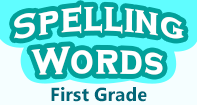- HOME
- GAMES
- WORD GAMES
- SPELLING WORDS FIRST GRADE
×
Change Avatar
Spelling Words First Grade
console:
Spelling Words First Grade
Teaching spellings to first-grade kids can be a fun and interactive process. Here are some strategies to help you teach spellings effectively:
- Start with Basic Words: Begin by introducing simple, high-frequency words that are familiar to the students. These can include common sight words like "cat," "dog," "hat," "run," and "jump." Use visual aids such as flashcards or pictures to make the words more memorable.
- Phonics Instruction: Teach the relationship between letters and sounds through phonics. Introduce letter-sound correspondence and demonstrate how different sounds can be represented by specific letters or letter combinations. For example, explain that the letter "c" can make the sound /k/ as in "cat."
- Sight Word Practice:Sight words are commonly used words that do not follow regular phonetic patterns. Provide regular practice and repetition of sight words by using flashcards, word games, and reading activities. Encourage students to recognize and spell these words by sight.
- Multi-Sensory Techniques: Engage students in multi-sensory activities that involve using their senses to reinforce spelling. For example, have them trace letters with their fingers, write words in sand or shaving cream, or create word puzzles using magnetic letters.
- Word Families: Introduce word families to help students understand spelling patterns. Explore words that have similar phonetic patterns, such as the "-at" family (cat, mat, hat) or the "-an" family (fan, can, pan). This helps students recognize and spell words with common word endings.
- Word Games and Activities: Incorporate word games and activities into your lessons to make spelling enjoyable. Use activities like word scavenger hunts, spelling bees, word building with letter blocks or tiles, and interactive online games designed for early learners.
- Contextual Writing:Encourage students to practice spelling by using words in context. Have them write simple sentences or short paragraphs using the words they are learning. This helps reinforce their understanding and application of spelling rules.
- Spelling Drills: Conduct regular spelling drills where students practice spelling words orally or through written exercises. Make it engaging by using timers, group competitions, or rewards to create a positive and motivating learning environment.
- Word Dictation: Read aloud words to students and have them write the corresponding spellings. Start with simple words and gradually increase the difficulty level based on their progress. Provide immediate feedback and correction.
- Personal Spelling Lists: Create personalized spelling lists for each student based on their individual needs and progress. Focus on words they find challenging or frequently misspell. Encourage them to practice these words at home with the support of their parents or caregivers.
Remember to make spelling lessons interactive, engaging, and age-appropriate. Celebrate their successes and provide positive reinforcement to motivate and encourage their spelling skills. Consistent practice and reinforcement will help them become more confident spellers over time.




